Jielin Qiu
LoCoBench: A Benchmark for Long-Context Large Language Models in Complex Software Engineering
Sep 11, 2025Abstract:The emergence of long-context language models with context windows extending to millions of tokens has created new opportunities for sophisticated code understanding and software development evaluation. We propose LoCoBench, a comprehensive benchmark specifically designed to evaluate long-context LLMs in realistic, complex software development scenarios. Unlike existing code evaluation benchmarks that focus on single-function completion or short-context tasks, LoCoBench addresses the critical evaluation gap for long-context capabilities that require understanding entire codebases, reasoning across multiple files, and maintaining architectural consistency across large-scale software systems. Our benchmark provides 8,000 evaluation scenarios systematically generated across 10 programming languages, with context lengths spanning 10K to 1M tokens, a 100x variation that enables precise assessment of long-context performance degradation in realistic software development settings. LoCoBench introduces 8 task categories that capture essential long-context capabilities: architectural understanding, cross-file refactoring, multi-session development, bug investigation, feature implementation, code comprehension, integration testing, and security analysis. Through a 5-phase pipeline, we create diverse, high-quality scenarios that challenge LLMs to reason about complex codebases at unprecedented scale. We introduce a comprehensive evaluation framework with 17 metrics across 4 dimensions, including 8 new evaluation metrics, combined in a LoCoBench Score (LCBS). Our evaluation of state-of-the-art long-context models reveals substantial performance gaps, demonstrating that long-context understanding in complex software development represents a significant unsolved challenge that demands more attention. LoCoBench is released at: https://github.com/SalesforceAIResearch/LoCoBench.
MoDoMoDo: Multi-Domain Data Mixtures for Multimodal LLM Reinforcement Learning
May 30, 2025Abstract:Reinforcement Learning with Verifiable Rewards (RLVR) has recently emerged as a powerful paradigm for post-training large language models (LLMs), achieving state-of-the-art performance on tasks with structured, verifiable answers. Applying RLVR to Multimodal LLMs (MLLMs) presents significant opportunities but is complicated by the broader, heterogeneous nature of vision-language tasks that demand nuanced visual, logical, and spatial capabilities. As such, training MLLMs using RLVR on multiple datasets could be beneficial but creates challenges with conflicting objectives from interaction among diverse datasets, highlighting the need for optimal dataset mixture strategies to improve generalization and reasoning. We introduce a systematic post-training framework for Multimodal LLM RLVR, featuring a rigorous data mixture problem formulation and benchmark implementation. Specifically, (1) We developed a multimodal RLVR framework for multi-dataset post-training by curating a dataset that contains different verifiable vision-language problems and enabling multi-domain online RL learning with different verifiable rewards; (2) We proposed a data mixture strategy that learns to predict the RL fine-tuning outcome from the data mixture distribution, and consequently optimizes the best mixture. Comprehensive experiments showcase that multi-domain RLVR training, when combined with mixture prediction strategies, can significantly boost MLLM general reasoning capacities. Our best mixture improves the post-trained model's accuracy on out-of-distribution benchmarks by an average of 5.24% compared to the same model post-trained with uniform data mixture, and by a total of 20.74% compared to the pre-finetuning baseline.
Evaluating Durability: Benchmark Insights into Multimodal Watermarking
Jun 06, 2024



Abstract:With the development of large models, watermarks are increasingly employed to assert copyright, verify authenticity, or monitor content distribution. As applications become more multimodal, the utility of watermarking techniques becomes even more critical. The effectiveness and reliability of these watermarks largely depend on their robustness to various disturbances. However, the robustness of these watermarks in real-world scenarios, particularly under perturbations and corruption, is not well understood. To highlight the significance of robustness in watermarking techniques, our study evaluated the robustness of watermarked content generated by image and text generation models against common real-world image corruptions and text perturbations. Our results could pave the way for the development of more robust watermarking techniques in the future. Our project website can be found at \url{https://mmwatermark-robustness.github.io/}.
Entity6K: A Large Open-Domain Evaluation Dataset for Real-World Entity Recognition
Mar 19, 2024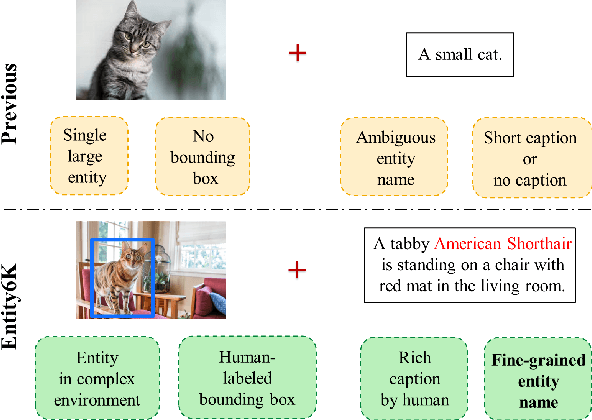
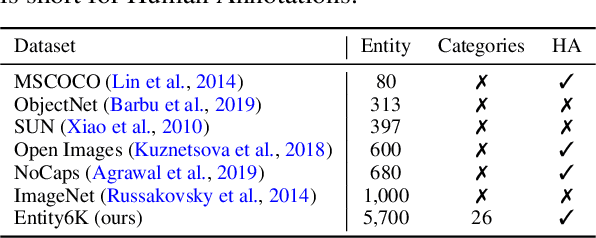
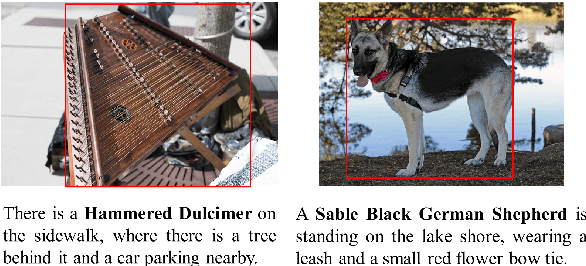
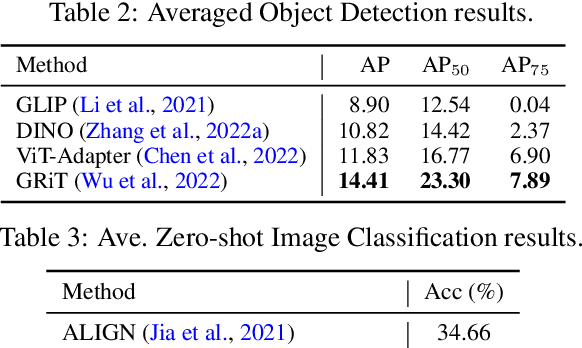
Abstract:Open-domain real-world entity recognition is essential yet challenging, involving identifying various entities in diverse environments. The lack of a suitable evaluation dataset has been a major obstacle in this field due to the vast number of entities and the extensive human effort required for data curation. We introduce Entity6K, a comprehensive dataset for real-world entity recognition, featuring 5,700 entities across 26 categories, each supported by 5 human-verified images with annotations. Entity6K offers a diverse range of entity names and categorizations, addressing a gap in existing datasets. We conducted benchmarks with existing models on tasks like image captioning, object detection, zero-shot classification, and dense captioning to demonstrate Entity6K's effectiveness in evaluating models' entity recognition capabilities. We believe Entity6K will be a valuable resource for advancing accurate entity recognition in open-domain settings.
SnapNTell: Enhancing Entity-Centric Visual Question Answering with Retrieval Augmented Multimodal LLM
Mar 07, 2024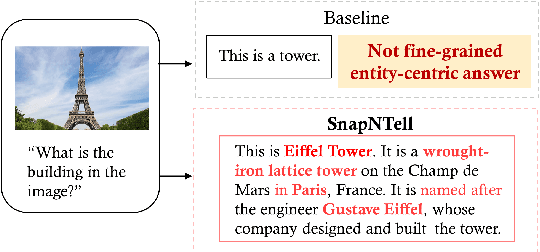

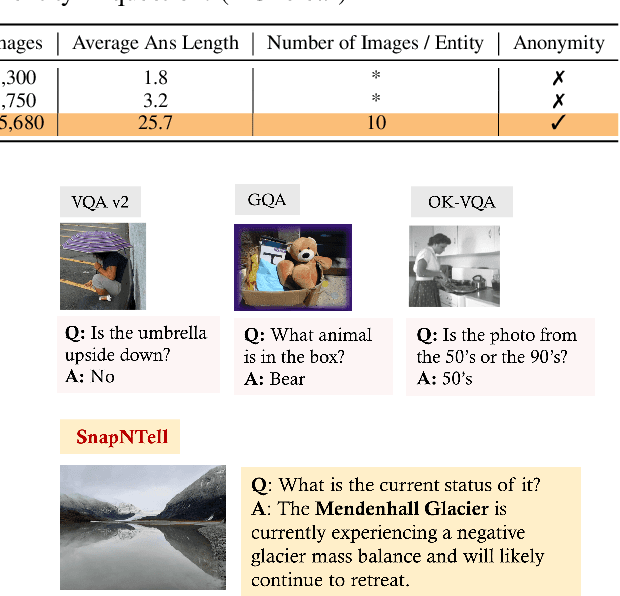
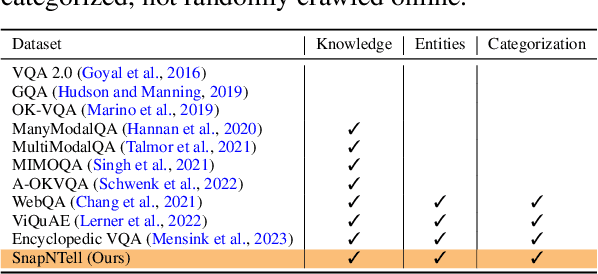
Abstract:Vision-extended LLMs have made significant strides in Visual Question Answering (VQA). Despite these advancements, VLLMs still encounter substantial difficulties in handling queries involving long-tail entities, with a tendency to produce erroneous or hallucinated responses. In this work, we introduce a novel evaluative benchmark named \textbf{SnapNTell}, specifically tailored for entity-centric VQA. This task aims to test the models' capabilities in identifying entities and providing detailed, entity-specific knowledge. We have developed the \textbf{SnapNTell Dataset}, distinct from traditional VQA datasets: (1) It encompasses a wide range of categorized entities, each represented by images and explicitly named in the answers; (2) It features QA pairs that require extensive knowledge for accurate responses. The dataset is organized into 22 major categories, containing 7,568 unique entities in total. For each entity, we curated 10 illustrative images and crafted 10 knowledge-intensive QA pairs. To address this novel task, we devised a scalable, efficient, and transparent retrieval-augmented multimodal LLM. Our approach markedly outperforms existing methods on the SnapNTell dataset, achieving a 66.5\% improvement in the BELURT score. We will soon make the dataset and the source code publicly accessible.
Offline Reinforcement Learning with Imbalanced Datasets
Jul 29, 2023Abstract:The prevalent use of benchmarks in current offline reinforcement learning (RL) research has led to a neglect of the imbalance of real-world dataset distributions in the development of models. The real-world offline RL dataset is often imbalanced over the state space due to the challenge of exploration or safety considerations. In this paper, we specify properties of imbalanced datasets in offline RL, where the state coverage follows a power law distribution characterized by skewed policies. Theoretically and empirically, we show that typically offline RL methods based on distributional constraints, such as conservative Q-learning (CQL), are ineffective in extracting policies under the imbalanced dataset. Inspired by natural intelligence, we propose a novel offline RL method that utilizes the augmentation of CQL with a retrieval process to recall past related experiences, effectively alleviating the challenges posed by imbalanced datasets. We evaluate our method on several tasks in the context of imbalanced datasets with varying levels of imbalance, utilizing the variant of D4RL. Empirical results demonstrate the superiority of our method over other baselines.
Embodied Executable Policy Learning with Language-based Scene Summarization
Jun 09, 2023Abstract:Large Language models (LLMs) have shown remarkable success in assisting robot learning tasks, i.e., complex household planning. However, the performance of pretrained LLMs heavily relies on domain-specific templated text data, which may be infeasible in real-world robot learning tasks with image-based observations. Moreover, existing LLMs with text inputs lack the capability to evolve with non-expert interactions with environments. In this work, we introduce a novel learning paradigm that generates robots' executable actions in the form of text, derived solely from visual observations, using language-based summarization of these observations as the connecting bridge between both domains. Our proposed paradigm stands apart from previous works, which utilized either language instructions or a combination of language and visual data as inputs. Moreover, our method does not require oracle text summarization of the scene, eliminating the need for human involvement in the learning loop, which makes it more practical for real-world robot learning tasks. Our proposed paradigm consists of two modules: the SUM module, which interprets the environment using visual observations and produces a text summary of the scene, and the APM module, which generates executable action policies based on the natural language descriptions provided by the SUM module. We demonstrate that our proposed method can employ two fine-tuning strategies, including imitation learning and reinforcement learning approaches, to adapt to the target test tasks effectively. We conduct extensive experiments involving various SUM/APM model selections, environments, and tasks across 7 house layouts in the VirtualHome environment. Our experimental results demonstrate that our method surpasses existing baselines, confirming the effectiveness of this novel learning paradigm.
MultiSum: A Dataset for Multimodal Summarization and Thumbnail Generation of Videos
Jun 07, 2023Abstract:Multimodal summarization with multimodal output (MSMO) has emerged as a promising research direction. Nonetheless, numerous limitations exist within existing public MSMO datasets, including insufficient upkeep, data inaccessibility, limited size, and the absence of proper categorization, which pose significant challenges to effective research. To address these challenges and provide a comprehensive dataset for this new direction, we have meticulously curated the MultiSum dataset. Our new dataset features (1) Human-validated summaries for both video and textual content, providing superior human instruction and labels for multimodal learning. (2) Comprehensively and meticulously arranged categorization, spanning 17 principal categories and 170 subcategories to encapsulate a diverse array of real-world scenarios. (3) Benchmark tests performed on the proposed dataset to assess varied tasks and methods, including video temporal segmentation, video summarization, text summarization, and multimodal summarization. To champion accessibility and collaboration, we release the MultiSum dataset and the data collection tool as fully open-source resources, fostering transparency and accelerating future developments. Our project website can be found at https://multisum-dataset.github.io/.
Multimodal Representation Learning of Cardiovascular Magnetic Resonance Imaging
Apr 16, 2023Abstract:Self-supervised learning is crucial for clinical imaging applications, given the lack of explicit labels in healthcare. However, conventional approaches that rely on precise vision-language alignment are not always feasible in complex clinical imaging modalities, such as cardiac magnetic resonance (CMR). CMR provides a comprehensive visualization of cardiac anatomy, physiology, and microstructure, making it challenging to interpret. Additionally, CMR reports require synthesizing information from sequences of images and different views, resulting in potentially weak alignment between the study and diagnosis report pair. To overcome these challenges, we propose \textbf{CMRformer}, a multimodal learning framework to jointly learn sequences of CMR images and associated cardiologist's reports. Moreover, one of the major obstacles to improving CMR study is the lack of large, publicly available datasets. To bridge this gap, we collected a large \textbf{CMR dataset}, which consists of 13,787 studies from clinical cases. By utilizing our proposed CMRformer and our collected dataset, we achieved remarkable performance in real-world clinical tasks, such as CMR image retrieval and diagnosis report retrieval. Furthermore, the learned representations are evaluated to be practically helpful for downstream applications, such as disease classification. Our work could potentially expedite progress in the CMR study and lead to more accurate and effective diagnosis and treatment.
Converting ECG Signals to Images for Efficient Image-text Retrieval via Encoding
Apr 13, 2023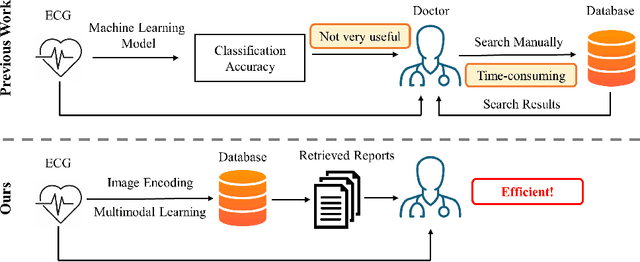
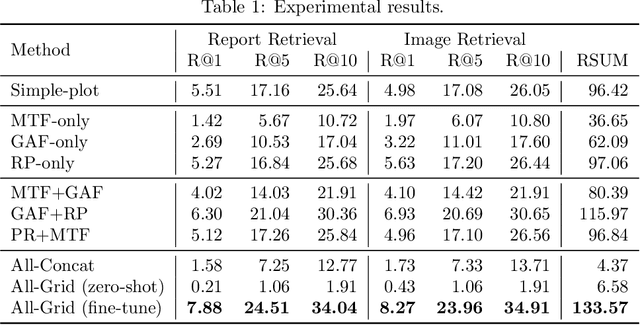


Abstract:Automated interpretation of electrocardiograms (ECG) has garnered significant attention with the advancements in machine learning methodologies. Despite the growing interest in automated ECG interpretation using machine learning, most current studies focus solely on classification or regression tasks and overlook a crucial aspect of clinical cardio-disease diagnosis: the diagnostic report generated by experienced human clinicians. In this paper, we introduce a novel approach to ECG interpretation, leveraging recent breakthroughs in Large Language Models (LLMs) and Vision-Transformer (ViT) models. Rather than treating ECG diagnosis as a classification or regression task, we propose an alternative method of automatically identifying the most similar clinical cases based on the input ECG data. Also, since interpreting ECG as images are more affordable and accessible, we process ECG as encoded images and adopt a vision-language learning paradigm to jointly learn vision-language alignment between encoded ECG images and ECG diagnosis reports. Encoding ECG into images can result in an efficient ECG retrieval system, which will be highly practical and useful in clinical applications. More importantly, our findings could serve as a crucial resource for providing diagnostic services in regions where only paper-printed ECG images are accessible due to past underdevelopment.
 Add to Chrome
Add to Chrome Add to Firefox
Add to Firefox Add to Edge
Add to Edge